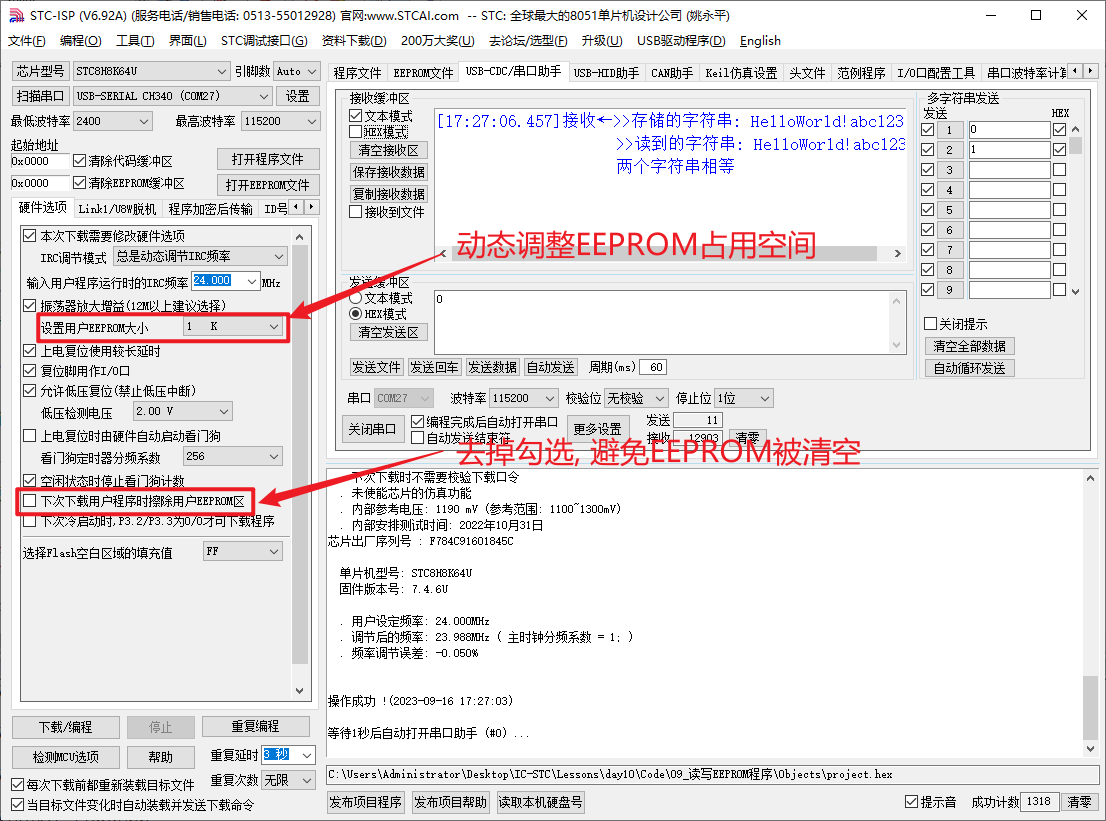EEPROM是一种可擦写可编程只读存储器(Electrically Erasable Programmable Read-Only Memory)的缩写。它是一种非易失性存储器,可以在不需要外部电源的情况下保持存储数据。与ROM不同,EEPROM可以通过电子擦除和编程来修改存储的数据,因此它是一种可重写的存储器。
EEPROM通常用于存储需要频繁修改的数据,例如系统配置信息、用户设置、校准数据等。由于EEPROM可以在系统运行时进行读写操作,因此它在许多应用中都具有很高的实用价值。
设置EEPROM
STC8H8K64U的EEPROM可以在烧录的时候指定大小, 如下图
读写String字符串
#include "Config.h"#include "UART.h"#include "EEPROM.h"#include <string.h>void UART_config(void) {// >>> 记得添加 NVIC.c, UART.c, UART_Isr.c <<<COMx_InitDefine COMx_InitStructure; //结构定义COMx_InitStructure.UART_Mode = UART_8bit_BRTx; //模式, UART_ShiftRight,UART_8bit_BRTx,UART_9bit,UART_9bit_BRTxCOMx_InitStructure.UART_BRT_Use = BRT_Timer1; //选择波特率发生器, BRT_Timer1, BRT_Timer2 (注意: 串口2固定使用BRT_Timer2)COMx_InitStructure.UART_BaudRate = 115200ul; //波特率, 一般 110 ~ 115200COMx_InitStructure.UART_RxEnable = ENABLE; //接收允许, ENABLE或DISABLECOMx_InitStructure.BaudRateDouble = DISABLE; //波特率加倍, ENABLE或DISABLEUART_Configuration(UART1, &COMx_InitStructure); //初始化串口1 UART1,UART2,UART3,UART4NVIC_UART1_Init(ENABLE,Priority_1); //中断使能, ENABLE/DISABLE; 优先级(低到高) Priority_0,Priority_1,Priority_2,Priority_3UART1_SW(UART1_SW_P30_P31); // 引脚选择, UART1_SW_P30_P31,UART1_SW_P36_P37,UART1_SW_P16_P17,UART1_SW_P43_P44}#define Max_Length 100 //读写EEPROM缓冲长度u8 xdata tmp[Max_Length]; //EEPROM操作缓冲void main() {u16 addr_sector = 0x0000;char *str = "HelloWorld!abc123!";u16 str_length = strlen(str); // 获取str的长度UART_config();EA = 1;// 擦除扇区, 一次性擦除一个扇区512字节, 从0x0000开始, 0x01FF// EEPROM_SectorErase(u16 EE_address);EEPROM_SectorErase(addr_sector);// // 写入数据. 字符串\int\long\float//// EEPROM_write_n(u16 EE_address,u8 *DataAddress,u16 number);EEPROM_write_n(addr_sector, str, str_length);// 读取数据. 字符串\int\long\float// EEPROM_read_n(u16 EE_address,u8 *DataAddress,u16 number);EEPROM_read_n(addr_sector, tmp, str_length);// 添加字符串结束符tmp[str_length] = '\0';printf(">>存储的字符串: %s\n", str);printf(">>读到的字符串: %s\n", tmp);if(strcmp(str, tmp) == 0){printf("两个字符串相等\n");}else {printf("两个字符串不等\n");}while(1) {}}
官方示例
串口命令设置: (命令字母不区分大小写)
E 0x0040—> 对0x0040地址扇区内容进行擦除.W 0x0040 1234567890—> 对0x0040地址写入字符1234567890.R 0x0040 10—> 对0x0040地址读出10个字节数据. ```c /——————————————————————————————————-/ / —- STC MCU Limited ————————————————————————/ / —- STC 1T Series MCU Demo Programme ———————————————-/ / —- Mobile: (86)13922805190 ————————————————————/ / —- Fax: 86-0513-55012956,55012947,55012969 ————————————/ / —- Tel: 86-0513-55012928,55012929,55012966 ————————————/ / —- Web: www.STCAI.com ——————————————————————-/ / —- BBS: www.STCAIMCU.com ————————————————————-/ / —- QQ: 800003751 ————————————————————————-/ / 如果要在程序中使用此代码,请在程序中注明使用了STC的资料及程序 / /——————————————————————————————————-/
include “config.h”
include “STC8G_H_GPIO.h”
include “STC8G_H_UART.h”
include “STC8G_H_Delay.h”
include “STC8G_H_NVIC.h”
include “STC8G_H_EEPROM.h”
include “STC8G_H_Switch.h”
/* 本程序功能说明 **
本例程基于STC8H8K64U为主控芯片的实验箱8进行编写测试,STC8G、STC8H系列芯片可通用参考.
通过串口对STC内部自带的EEPROM(FLASH)进行读写测试。
对FLASH做扇区擦除、写入、读出的操作,命令指定地址。
默认波特率: 115200,N,8,1.
串口命令设置: (命令字母不区分大小写) E 0x0040 —> 对0x0040地址扇区内容进行擦除. W 0x0040 1234567890 —> 对0x0040地址写入字符1234567890. R 0x0040 10 —> 对0x0040地址读出10个字节数据.
注意:下载时,下载界面”硬件选项”中设置用户EEPROM大小,
并确保串口命令中的地址在EEPROM设置的大小范围之内。
下载时, 选择时钟 22.1184MHz (可以在配置文件”config.h”中修改).
**/
define Max_Length 100 //读写EEPROM缓冲长度
/* 本地常量声明 **/
/* 本地变量声明 **/ u8 xdata tmp[Max_Length]; //EEPROM操作缓冲
/* 本地函数声明 **/
/* 外部函数和变量声明 */
/* IO配置函数 */ void GPIO_config(void) { GPIO_InitTypeDef GPIO_InitStructure; //结构定义
GPIO_InitStructure.Pin = GPIO_Pin_0 | GPIO_Pin_1; //指定要初始化的IO, GPIO_Pin_0 ~ GPIO_Pin_7GPIO_InitStructure.Mode = GPIO_PullUp; //指定IO的输入或输出方式,GPIO_PullUp,GPIO_HighZ,GPIO_OUT_OD,GPIO_OUT_PPGPIO_Inilize(GPIO_P3,&GPIO_InitStructure); //初始化
}
/* 串口初始化函数 */ void UART_config(void) { COMx_InitDefine COMx_InitStructure; //结构定义
COMx_InitStructure.UART_Mode = UART_8bit_BRTx; //模式, UART_ShiftRight,UART_8bit_BRTx,UART_9bit,UART_9bit_BRTxCOMx_InitStructure.UART_BRT_Use = BRT_Timer1; //选择波特率发生器, BRT_Timer1, BRT_Timer2 (注意: 串口2固定使用BRT_Timer2)COMx_InitStructure.UART_BaudRate = 115200ul; //波特率, 一般 110 ~ 115200COMx_InitStructure.UART_RxEnable = ENABLE; //接收允许, ENABLE或DISABLECOMx_InitStructure.BaudRateDouble = DISABLE; //波特率加倍, ENABLE或DISABLEUART_Configuration(UART1, &COMx_InitStructure); //初始化串口1 UART1,UART2,UART3,UART4NVIC_UART1_Init(ENABLE,Priority_1); //中断使能, ENABLE/DISABLE; 优先级(低到高) Priority_0,Priority_1,Priority_2,Priority_3
}
/**/
u8 CheckData(u8 dat) { if((dat >= ‘0’) && (dat <= ‘9’)) return (dat-‘0’); if((dat >= ‘A’) && (dat <= ‘F’)) return (dat-‘A’+10); if((dat >= ‘a’) && (dat <= ‘f’)) return (dat-‘a’+10); return 0xff; }
//======================================================================== // 函数: u16 GetAddress(void) // 描述: 计算各种输入方式的地址. // 参数: 无. // 返回: 16位EEPROM地址. // 版本: V1.0, 2013-6-6 //======================================================================== u16 GetAddress(void) { u16 address; u8 i,j;
address = 0;if((RX1_Buffer[2] == '0') && (RX1_Buffer[3] == 'X')){for(i=4; i<8; i++){j = CheckData(RX1_Buffer[i]);if(j >= 0x10) return 65535; //erroraddress = (address << 4) + j;}return (address);}return 65535; //error
}
/** 获取要读出数据的字节数 **/ u8 GetDataLength(void) { u8 i; u8 length;
length = 0;for(i=9; i<COM1.RX_Cnt; i++){if(CheckData(RX1_Buffer[i]) >= 10) break;length = length * 10 + CheckData(RX1_Buffer[i]);}return (length);
}
/* 主函数 */ void main(void) { u8 i,j; u16 addr; u8 status;
EAXSFR(); /* 扩展寄存器访问使能 */GPIO_config();UART_config();EA = 1;PrintString1("STC8系列单片机EEPROM测试程序,串口命令设置如下:\r\n"); //UART1发送一个字符串PrintString1("E 0x0040 --> 对0x0040地址扇区内容进行擦除\xfd.\r\n"); //UART1发送一个字符串PrintString1("W 0x0040 1234567890 --> 对0x0040地址写入字符1234567890.\r\n"); //UART1发送一个字符串PrintString1("R 0x0040 10 --> 对0x0040地址读出10个字节内容.\r\n"); //UART1发送一个字符串while(1){delay_ms(1);if(COM1.RX_TimeOut > 0) //超时计数{if(--COM1.RX_TimeOut == 0){for(i=0; i<COM1.RX_Cnt; i++) TX1_write2buff(RX1_Buffer[i]); //把收到的数据原样返回,用于测试status = 0xff; //状态给一个非0值if((COM1.RX_Cnt >= 8) && (RX1_Buffer[1] == ' ')) //最短命令为8个字节{for(i=0; i<8; i++){if((RX1_Buffer[i] >= 'a') && (RX1_Buffer[i] <= 'z')) RX1_Buffer[i] = RX1_Buffer[i] - 'a' + 'A'; //小写转大写}addr = GetAddress();if(addr < 63488) //限制在0~123扇区{if(RX1_Buffer[0] == 'E') //写入N个字节{EEPROM_SectorErase(addr); //擦除扇区PrintString1("擦除\xfd成功!\r\n");status = 0; //命令正确}else if((RX1_Buffer[0] == 'W') && (RX1_Buffer[8] == ' ')) //写入N个字节{j = COM1.RX_Cnt - 9;if(j > Max_Length) j = Max_Length; //越界检测//EEPROM_SectorErase(addr); //擦除扇区EEPROM_write_n(addr,&RX1_Buffer[9],j); //写N个字节PrintString1("已写入");if(j >= 100) {TX1_write2buff(j/100+'0'); j = j % 100;}if(j >= 10) {TX1_write2buff(j/10+'0'); j = j % 10;}TX1_write2buff(j%10+'0');PrintString1("字节!\r\n");status = 0; //命令正确}else if((RX1_Buffer[0] == 'R') && (RX1_Buffer[8] == ' ')) //PC请求返回N字节EEPROM数据{j = GetDataLength();if(j > Max_Length) j = Max_Length; //越界检测if(j > 0){PrintString1("读出");TX1_write2buff(j/10+'0');TX1_write2buff(j%10+'0');PrintString1("个字节内容如下:\r\n");EEPROM_read_n(addr,tmp,j);for(i=0; i<j; i++) TX1_write2buff(tmp[i]);TX1_write2buff(0x0d);TX1_write2buff(0x0a);status = 0; //命令正确}}}}if(status != 0) PrintString1("命令错误!\r\n");COM1.RX_Cnt = 0;}}}
} /**/ ```

